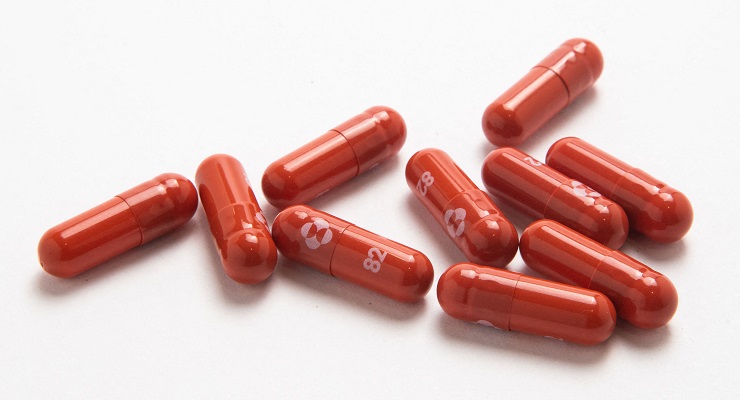
Australia has ordered 300,000 doses of COVID-19 treatment drug Molnupiravir. The company which manufactures the drug, Merck, is selling it to the US for 40 times what it costs to make.
Drug pricing is tricky: no one would begrudge drug companies making a reasonable profit at this time, given how much we need these medicines and how much development is going into them. But secret dealings mean determining what’s reasonable profit and what’s price gouging is nearly impossible.
Fortunately, Australia is in a good spot to negotiate what is considered a reasonable price for drugs — despite our long lockdowns and high COVID-19 case numbers.
How does Australia pay for drugs?
When drugs get added to the Pharmaceutical Benefits Scheme (PBS) — the list of medicines available to those with Medicare cards at a government-subsidised price — the Commonwealth will go into negotiations with the manufacturer about what the price is going to be.
There are two separate prices on the PBS website. There’s the published price, which is what the government publicly says it paid for the drug or what the manufacturer sells the drug for, and then the price the patient pays.
The PBS has an economics advisory committee, which looks at new medicines and the values of those products to the health system. If they consider that the pricing requested is disproportionate to the value of that medicine, then there’s no deal.
The Commonwealth is very good at making confidential negotiations with companies. Often the manufacturer will give large discounts when bulk volumes are expected, so we’re often not actually paying as much as what’s listed on the PBS website.
Unfortunately, those discussions are commercial in confidence, because the drug company wants to be able to negotiate the best possible price with other countries.
Australia has a good negotiating ability because the PBS is really the only main market in the community, so it’s acting as a single buyer. They’ve got a lot of negotiating power because you’re talking about buying on behalf of the whole country.
Australian drug prices are low by world standard. In 2019, Australia ranked 11th out of 50 countries for cheapest drugs, paying 36% less than the median price for generic drugs and 7% less for branded drugs (though New Zealanders pay 87% less than the median for generic drugs).
Has our negotiating power been affected by this outbreak?
Melbourne has experienced the world’s longest lockdown and Australia’s 2021 has been vastly different to many other developed countries.
Given that when negotiating prices, the government considers the value the medicine will have on the population’s health and the economy, is Australia in a poor position to negotiate?
Fortunately given our current high vaccination rates, that’s not likely. A year ago, COVID-19 drug manufacturers would have had a stronger case for a higher price when the potential for harm and contagion would have been much higher than it is now.
Because COVID-19 treatments like Molnupiravir are given to someone when they’re already ill, and given we’re expecting fewer COVID-19 cases — even in the current outbreak — because of vaccination rates, we’re much less vulnerable to unreasonable prices than we would have been a year ago.
Is price gouging a concern?
There are limited international laws around what drug companies can charge for their products. The closest thing is patent legislation which usually gives companies seven years of protection for their product. After that, anyone else can manufacture the drug generically and that’s when we see prices start to drop.
Within those seven years, manufacturers do have to find a buyer who is willing to pay for the drug. Whole country systems and big insurers are not willing to pay prices that aren’t commensurate with the benefit.
To call it profiteering, we have to know what the manufacturing cost per unit is. But you also have to factor in the massive increase in staff and massive investment in equipment throughout the pandemic, as well as consider all the drug development that took place for drugs that didn’t clear hurdles like efficacy and safety.
While there certainly have been some very healthy profits made in some senses across the pandemic, we do want a thriving pharmaceutical industry that is profitable for them to operate, because if that didn’t continue, we’d all be in strife.
We need open conversations about what’s reasonable profit and what’s not, but that’s really hard to do without knowing what the margins are.








40 times is not a ‘reasonable’ profit, it is an obscene profit.
There’s only ever one winner in these negotiations – The Drug Companies.
“During the first six months of 2021, Pfizer paid $4.4 billion of cash dividends”
I would say their profits are pretty good.
https://investors.pfizer.com/investor-news/press-release-details/2021/PFIZER-REPORTS-SECOND-QUARTER-2021-RESULTS/default.aspx
I would struggle to posit that Australia is a victim of high prices and access to purchasing Covid related drugs or vaccines when the Federal Government took responsibility for procurement, logistics and delivery well over a year ago.
Australia is one of the wealthiest nations in the world per capita then why do we act, using the Trumpism, like such losers, and worse view it as acceptable?
While Australia is happy to act like a less developed and or immature nation and democracy, the most pressing issue is to get deals on IP or patents from pharma co’s to allow more contract manufacturing (i.e. via India, China etc.) for cheap Covid vaccines and/or drugs, quickly, for the developing world.
The big issue for this new drug, and many others, is that much of the research dollars come from governments directly or via universities. The drug companies somehow are allowed to use University research and then patent drugs as though they did all the research.
Reports that Merck may allow generic production in India and other countries may be recognition that govt funds paid for the research, but who would know, commercial in confidence and all that.